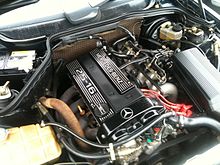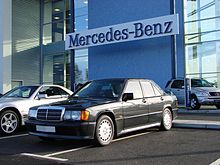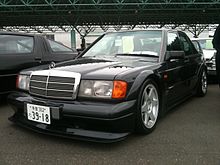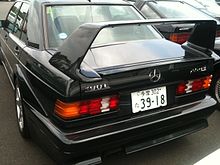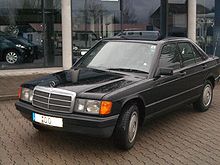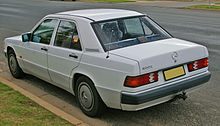- Mercedes-Benz W201
-
This article is about the entry-level luxury car produced from 1982 to 1993. For other models sold with the same name, see Mercedes-Benz 190.
Mercedes 190E, C Class 
Manufacturer Mercedes-Benz Production 1982–1993
1,874,668 built [1]Assembly Bremen, Germany
Sindelfingen, Germany
Thonburi, Thailand (TAAP)Successor Mercedes-Benz C-Class Class Compact executive car Body style 4-door saloon Layout FR layout Engine 1.8L 8v I4 - 2.0L 8v I4 - 2.3L 8v I4 - 2.3L 16v I4 - 2.5L 16v I4
2.6L I6
Diesel 2.0L - 2.2L - 2.5L Non-Turbo
Diesel 2.5L TurboTransmission 4-speed automatic
4-speed manual
5-speed manualWheelbase 104.9 in (2,664 mm) Length 175.1 in (4,448 mm)
1988-1990 Base: 175.0 in (4,445 mm)Width 1988-1990: 66.1 in (1,679 mm)
1991-93: 66.5 in (1,689 mm)Height 1988-1990: 54.7 in (1,389 mm)
1991-93: 54.1 in (1,374 mm)The Mercedes-Benz W201 is a compact executive car manufactured by Mercedes-Benz from 1982–1993, positioned below the Mercedes-Benz E-Class and S-Class — and marketed under variants of the Mercedes 190 nameplate.
The W201 featured a patented rear 5-link suspension, subsequently used in E and C class models, front and rear anti-roll bars, anti-dive and anti-squat geometry — as well as available airbags, ABS brakes and seatbelt pretensioners.
The W201 enjoyed strong sales in Europe but fared poorly in the United States.[2] Series production ended April 13, 1993 after the manufacture of approximately 1.8 million examples.[1] The 190 and its variants were succeeded in the compact executive car segment by the C-Class, a newly created nameplate.
Contents
Background
Mercedes spent £600 million researching and developing the 190 and subsequently said it was 'massively over-engineered'.[3] The W201-based 190 was introduced in November 1982.
Local 'red tape' in Bremen (which produced commercial vehicles at the time) prevented Daimler-Benz from building the 190 there, so production was started in Sindelfingen at a capacity of just 140,000 units per year. Eventually after just the first year, Bremen was cleared for production of the 190, replacing its commercial vehicle lines, and there the 190 was built with the first running modifications since release.
The 190E model has a super-efficient distributor pump injection system. This uses the air entering the throttle body to adjust the air fuel mixture accordingly, eliminating the need for complex computers. As a result, the 190E is well known for lasting well over 300,000 miles.
190E 2.3-16 & 2.5-16 "Cosworth"
Back in the late 1970s, Mercedes competed in rallying with the big V8-powered Coupés of the R107 Series, mainly the light-weight Mercedes 450 SLC 5.0. Mercedes wished to take the 190 E rallying, and asked British race car engineering company Cosworth to develop an engine with 320 bhp (239 kW) for the rally car. This project was known as project "WAA" by Cosworth".[4] During this time, the Audi Quattro with its all wheel drive and turbocharger was launched, making the 2.3-16v appear over-matched. With a continued desire to compete in high-profile motor sport with the 190, and also now an engine to do it with, Mercedes turned to the Deutsche Tourenwagen Meisterschaft (DTM) (German Touring Car Championship) motor sport series instead. Cars racing in this championship, however, had to be based on a roadgoing model. Mercedes therefore had to put into series production a 190 fitted with a detuned version of the Cosworth engine. This high performance model was known as the 190 E 2.3-16, and debuted at the Frankfurt Auto Show in September 1983, after its reputation had already been established. Three cars, only slightly cosmetically altered, had set three world records in August at the Nardo testing facility in Italy, recording a combined average speed of 154.06 mph (247.94 km/h) over the 50,000 km endurance test, and establishing twelve international endurance records. The Mercedes 190-E Cosworth was also featured on the second episode in season fifteen of the extremely popular car show Top Gear.
Engine
The Cosworth engine was based on the 2.3-liter 8-valve 136 hp (101 kW) unit already fitted to the 190- and E-Class series. Cosworth developed the cylinder head, "applying knowledge we've learnt from the DFV and BDA".[5] It was made from light alloy using Coscast's unique casting process and brought with it dual overhead camshafts and four valves per cylinder, meaning 16 valves total which were developed to be the "largest that could practically be fitted into the combustion chamber".[5]
In roadgoing trim, the 190 E 2.3-16 produced 49 hp (36 kW) and 41 ft·lbf (55 N·m) of torque more than the basic single overhead cam 2.3 I4 engine on which it was based. The 2.3 L 16 valve engine made "185 hp (137 kW) at 6,200 rpm and 174 ft·lbf (235 N·m) at 4,500 rpm, the oversquare 95.50 x 80.25 mm bore and stroke dimensions ensuring that it revs easily up to the 7000 rpm redline".[6] Acceleration from 0–100 km/h (62 mph) was less than eight seconds, and the top speed was 230 km/h (143 mph).[6]
US-Specification cars had a slightly reduced compression ratio (9.7:1 instead of 10.5:1), and were rated at 167 hp (125 kW) @ 5800 rpm and 162 lb·ft (220 N·m) @ 4750.
The roadgoing version of the engine was reconfigured with reduced inlet and exhaust port sizes, different camshaft profiles, no dry sump configuration and Bosch K-jetronic replacing the specialised Kugelfischer fuel injection. These changes helped bring power down to the required 185 bhp (138 kW) specification, but still resulted in a "remarkably flexible engine, with a very flat torque curve and a wide power band".[5] The heads for the engines were cast at Cosworth's Coscast foundry in Worcester and sent to Germany to be fitted to the rest of the engine, parts of which were different from the standard 2.3 including light pressed alloy pistons, and rings designed to withstand higher engine speeds, whilst con-rods, bearings and bearing caps were found to be strong enough as standard and left unaltered.[5]
2.5 model
An enlarged 2.5 L engine replaced the 2.3 L in 1988. It offered double valve timing chains to fix the easily snapping single chains on early 2.3 engines, and increased peak output by 17 hp (12.5 kW) with a slight increase in torque. For the European market without catalyst (RÜF) the car delivered 204 bhp (150 kW). Catalyst equipped 2.5-16s produced a slightly reduced 197 bhp (147 kW). It is debated whether the 2.5 L engine was developed and built by Mercedes or Cosworth.[citation needed] Mercedes was not keen to broadcast the fact that their most sporting saloon car has an engine developed by a British company. However some cylinder heads from 2.5 L cars are stamped with the Coscast logo indicating they were cast at Cosworth's foundry just like the 2.3s. Cosworth also list the project code "WAB" for the development of the 2.5-16 valve head just as they do for the 2.3-16 valve head. Car program Top Gear predicted this 2.5 model to be one of the future classics in the car world, because of its relatively unknown history and rivalry with the BMW M3.[4][7]
16v differences
Due to their performance, the 16 valve cars were different from the other 190 models. The body kit on the 2.3-16 and 2.5-16 reduced the drag coefficient to 0.32, one of the lowest CD values on a four door saloon of the time, whilst also reducing lift at speed. The steering ratio was quicker and the steering wheel smaller than that on other 190s, whilst the fuel tank was enlarged from 55 to 70 L. The Getrag 5-speed manual gearbox was unique to the 16 valve and featured a 'racing' gear pattern with 'dog-leg' first gear, left and down from neutral. This meant that the remaining 2nd, 3rd, 4th and 5th gears were in a simple H pattern allowing fast and easy selection. The gearchange quality was, however, noted as "notchy, baulky",[6] criticisms which weren't levelled at the BMW M3 (E30) which shared the same gearbox. The pattern is also unusual in that the driver engages reverse by shifting left and up from neutral, as for first gear in a conventional pattern. This was demonstrated in a Top Gear episode (S15E02) where James May took a 190E Cosworth and repeatedly confused (or perhaps pretended to confuse) reverse and first gear. An oil cooler was fitted to ensure efficient oil cooling for the inevitable track use many of these cars were destined for.
The strictly four-seater interior had Recaro sports seats with strong side bolsters for front and rear passengers. 3 extra dials - an oil temperature gauge, stopwatch and voltmeter - were included in the centre console. The 190 E 2.3-16 was available in only two colours, Blue-Black metallic (Pearl Black in the US), and Smoke Silver. The 2.5-16 added Almandine Red and Astral Silver.
All 2.3-16 valve 190 models are fitted with a Limited Slip Differential (LSD) as standard. They were also available with Mercedes' ASD system which was standard equipment on the 2.5-16v. The ASD is an electronically controlled, hydraulically locking differential which activates automatically when required. The electronic control allows varied amounts of differential lock from the standard 15% right up to 100%. It is not a traction control system however, and can only maximize traction rather than prevent wheel spin. Activation of the ASD system is indicated by an illuminating amber triangle in the speedometer.
The suspension on 16 valve models is very different from the standard 190 (W201). As well as being lower and stiffer, it has quicker dampers, larger anti-roll bars, harder bushings and hydraulic Self-levelling suspension (SLS) on the rear. This allows the rear ride height to remain constant even when the car is fully loaded.
At the inauguration of the new, shorter Nürburgring in 1984, a race with identical cars was held, with former and current F1 pilots at the wheel. A rather unknown young driver named Ayrton Senna took First Place in that race.
Private Teams such as AMG later entered the 2.3-16 in touring cars races, especially the DTM. In the late 1980s, the 2.5-16 (never released in the United States) raced many times, against the similar BMW M3 and even the turbocharged Ford Sierra Cosworth.
Evolution models
With the debut of the BMW M3 Sport Evolution, Mercedes' direct competitor, it became obvious that the 2.5-16 needed a boost for the circuit. In March 1989, the 190 E 2.5-16 Evolution debuted at the Geneva Auto Show. The Evo I, as it came to be called, had a new spoiler and wider wheel arches. Many changes were made to under-the-skin components such as brakes and suspension. There was a full SLS suspension allowing vehicle ride height to be adjusted from an interior switch. All were intended to allow the Evolution cars to be even more effective round a track.
The Evo I's output similar to the 202 bhp (151 kW) of the "regular" 2.5-16. However this car had a redesigned engine of similar capacity but, most importantly, a shorter stroke and bigger bore which would allow for a higher rev limit and improved top-end power capabilities. Additional changes stretch to "rotating masses lightened, lubrication improved and cam timing altered".[8] Cosworth also list a project code "WAC" for the development of the short-stroke Evolution engine.[4][7]
Only 502 units of the Evolution model were produced for homologation in compliance with DTM rules. For those customers desiring even more performance, a PowerPack option engineered by AMG was available for DM 18,000. The PowerPack option included hotter camshafts, a larger diameter throttle body, more aggressive ignition and fuel management as well as optimization of the intake and exhaust systems. The net result was an additional 30 bhp (22 kW).
In March 1990, at the Geneva Auto Show, the 190 E 2.5-16 Evolution II was shown. With the success of the first Evolution model, this model's 502-unit production was already sold before it was unveiled.[citation needed] This car retailed in 1990 for USD $80,000.
The "Evo II" included the AMG PowerPack fitted to the same short stroke 2.5 engine as the Evolution, as well as a full SLS suspension allowing vehicle ride height to be adjusted from an interior switch. An obvious modification to the Evolution II is a radical body kit (designed by Prof. Richard Eppler from the University of Stuttgart) with a large adjustable rear wing, rear window spoiler, and Evolution II 17 inch wheels. The kit served an aerodynamic purpose — it was wind tunnel tested to reduce drag to 0.29, while at the same time increasing downforce. Period anecdotes tell of a BMW executive who was quoted as saying "if that rear wing works, we'll have to redesign our wind tunnel." The anecdote claims that BMW did.[vague]
As mentioned 500 were made in "blauschwarz" blue/black metallic. But the last two, numbers 501 and 502 were made in astral silver.
It is clear that these cars are now extremely rare in the collectors cars market place. Very few, if any have returned for resale in Europe as these cars are now clearly in the hands of long term collectors or are in personal storage. Of interesting fact is that a significant number of Evolution II cars were privately imported to Japan and that these cars appear to be the only units available for trade as of lately. Latest appearance in USS Tokyo auction group resulted in a wholesale price at 4,050,000 yen for a 65,000 km pristine example and this car was the third of its kind to appear in the 2010 to 2011.
16V AMG power pack
Available only to 2.5-16 and Evolution I models, optional AMG Power Pack increased power to 224 bhp (166 kW) at 7,200 rpm and torque to 181 lb·ft (245 N·m) at 5,000 rpm, whilst pushing the top speed up to 155 mph. In their final incarnations, these engines produced up to 350 bhp (260 kW) in racing tune.
Engines
Engine displacement (cc) Model Configuration Power PS (kW) Max Speed mph (km/h) Model Badge 1996 Carb I4 8V 105 (77) 115 (185) 190 1737 Inj I4 8V 107 (79) 115 (185) 190E 1.7 1797 Inj I4 8V 109 (80) 115 (185) 190E 1.8, 180E (AUS) 1996 Inj I4 8V 122 (89) 122 (195) 190E, 190E 2.0 2298 Inj I4 8V 136 (100) 124 (200) 190E 2.3 2597 Inj I6 12V 166 (122) 133 (215) 190E 2.6 2299 Inj ECE I4 16V 185 (136) 143 (235) 190E 2.3-16 2299 Inj RÜF I4 16V 177 (130) 140 (225) 190E 2.3-16 2299 Inj KAT I4 16V 170 (125) 137 (220) 190E 2.3-16 2498 Inj RÜF I4 16V 204 (150) 146 (235) 190E 2.5-16 2498 Inj KAT I4 16V 194 (143) 143 (230) 190E 2.5-16 2498/2463 Inj I4 16V AMG p/p 225 (165) 152 (244) 190E 2.5-16 2463 Inj KAT I4 16V Evolution (Evo I) 194 (143) 143 (230) 190E 2.5-16 2463 Inj I4 16V Evolution II (Evo II) 235 (173) 155 (250) 190E 2.5-16 1997 Diesel I4 8V 75 (55) 100 (160) 190D 2.0 2199 Diesel I4 8V 73 (54) 100 (160) 190D 2.2 2497 Diesel I5 10V 94 (69) 109 (175) 190D 2.5 2497 Diesel Turbo I5 10V 122 (89) 119 (192) 190D 2.5 TURBO The turbo diesel model listed was not marketed in right hand drive form for the UK.
AMG models
AMG was not part of Mercedes-Benz when the 190 was first produced, but a separate racing and tuning company. As AMG had a lot of racing experience, they were tuning all the factory petrol engines for the customers and 190 E was one of them. Engine tuning added 25 bhp (19 kW). They fitted aerodynamic features (spoilers) improving Cw and high speed stability, alloy wheels, leather interior and larger engines up to 6 litre V8's. After victories in DTM with AMG 190 E 16V's, Mercedes bought AMG in 1991. The 190 E 3.2 AMG was the first model sold through Mercedes-Benz dealerships with Mercedes-Benz new car warranty. About 200 complete cars were made, in black or silver: they were very expensive (about $90,000). Besides 200 complete 190 E 3.2 AMG's, Mercedes-Benz sold AMG body kits and 3.2l AMG engines separately, so there are 190's fitted with those features from factory or afterward. Sporty 190E 3.2 AMG straight-six 24 valve engines produced 234 bhp (174 kW), and reached 260 km/h (162 mph).
Diesel models
The w201 190D is known for its extreme reliability and ruggedness with many examples doing more than 500,000 miles without any major work. The 190D was available in three different engines. The 2.0 was the baseline, and available in Europe only. The 2.2 was only available in 1984 and 1985 in the USA. The 2.5 was available in the late 80's and early 90's. The 2.5 Turbo was available in 1987 only, and is now a collectors item. The exterior of the 2.5 Turbo differentiates from the other models in that it has fender vents in the front fenders for the turbo to breathe.
Limited editions
For the UK and Irish market a special edition 190 was released for the 1993 model year. The car was given the badge name 190LE though on the rear boot lid it read 190E (on the left hand side of the lock) and LE on the right hand side. Roughly 1000 LEs were produced and each one came with a large A3 sized certificate giving each car a unique number.
LEs were available in three colours only; Azzuro Blue (blue/purple), Brilliant Silver and Rosso Red (Burgundy). The Azzuro blue coloured cars came with a grey checked cloth interior, the silver ones with black checked cloth and the Rosso Red with biscuit/cream checked cloth.
LEs were equipped with extra features that had been options on the other models and were only available with the 1.8 or 2.0 litre engine. Both the 1.8 and 2.0 litre models were equipped with a standard electric tilt and slide steel sunroof, four electric windows, electric aerial, 8 hole alloy wheels, Blaupunkt Verona CR43 Radio/cassette and walnut wood trim (as opposed to Zebrano wood). The 2.0-litre-engined version had in addition rear headrests and a front armrest. The LE was nearly £3500 cheaper than a non-LE 1.8 car of identical specification, and £2000 cheaper for a 2.0 litre.
No further options could be added to LE cars from the factory - though some were equipped with other dealer-installed items.
In Australia a limited run of 180E W201 cars could be bought from 1991 to 1993. This was essentially a 190E 1.8 with very basic trim (cloth seats, manual windows etc.), which allowed it to undercut the Luxury Car Tax introduced by the government at the time.
In 1993, for the U.S. market, 2 LE models were offered, limited to 1400 units (700 190E 2.3 LE and 700 190E 2.6 LE). The 2.3 LE was only offered in Emerald Green while the 2.6 was only offered in black.
References
- ^ a b Kittler, Eberhard (2001). Deutsche Autos seit 1990, Band 6. Stuttgart: Motorbuch Verlag. p. 100. ISBN 3-613-02052-1.
- ^ View all comments that have been posted about this article. (2007-06-28). "Warren Brown - Compact Luxury Taken to a Higher Level". Washingtonpost.com. http://www.washingtonpost.com/wp-dyn/content/article/2007/06/28/AR2007062801077_pf.html. Retrieved 2010-10-10.
- ^ "Top 10: greatest-ever Mercedes". http://cars.uk.msn.com/features/photos.aspx?cp-documentid=147900011.
- ^ a b c "Cosworth project list". http://www.siipicossu.com/CostinDuckworth.htm.
- ^ a b c d "Flying the Flag". Autocar Magazine. August 7, 1985. pp. 32–33.
- ^ a b c "Shooting Star". Autocar Magazine. August 7, 1985. pp. 35–40.
- ^ a b "Cosworth type reference". http://www.race-cars.com/utility/coswrthr.htm.
- ^ "Les Grandes Marques a Monaco, Bonhams (16th May 2005)". Practical Classics. http://www.practicalclassics.co.uk/auctionlot/by-id/1962785854/.
- ^ "Mercedes-Benz PKW vehicle list". http://www.mercedes-seite.de/mercedes/pkw/index.html.
- ^ "Produktinformationen fur die Mercedes-Benz-Vertriebsorganisation 190 E 2.5-16 Motor M 102 mit 16 Ventilen". http://www.smileeverymile.com/Templates/Mercedes_literature%20brochures%20index.htm.
External links
- www.mercedes-190.co.uk The original UK Mercedes w201 190 owners club & forum with members from all over the world offering a wealth of knowledge on all things Mercedes 190.
Categories:- Mercedes-Benz vehicles
- Compact executive cars
- Rear wheel drive vehicles
- 1980s automobiles
- 1990s automobiles
- Sedans
- Vehicles introduced in 1982
Wikimedia Foundation. 2010.


